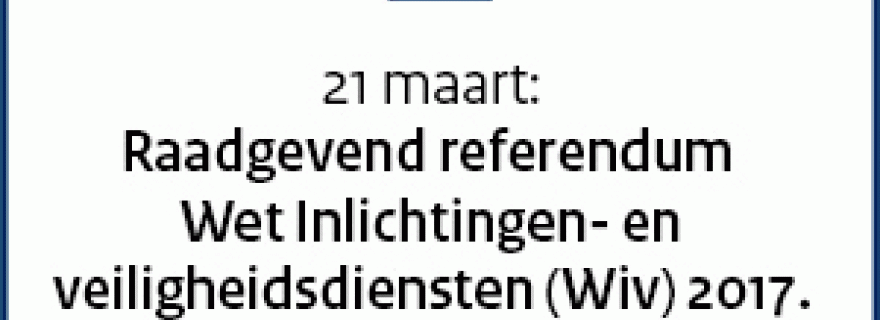Secret services and the democratic state
A special edition of 'Justitiële Verkenningen' aims to provide an academic perspective on the new Act on Intelligence and Security Services in the Netherlands
If the referendum of 21 March 2018, about the new Act on the Intelligence and Security Services (abbreviated in Dutch as ‘Wiv’), has achieved at least one thing, it is triggering nation-wide attention to and debate on the new Act. Both on small and large scale, debates about the new Act take place, and more journalistic attention than ever is focussed on this topic.
In order to provide an academic perspective on the new Act, we decided to compile a special issue of ‘Justitiële Verkenningen’ on this theme. Together with chief editor Marit Scheepmaker, Constant Hijzen has composed a special edition of Justitiële Verkenningen, under the title ‘Secret services in the democratic state’. He did this in name of the research group Intelligence and Security of the Institute of Security and Global Affairs of Leiden University. With the academic perspectives in this special edition, we hope to provide a valuable contribution to the nation-wide discussion on the Act. The articles take you past the headlines in the newspapers, and focus on the political and societal context, the law itself and the workings of the Intelligence and Security Services. So, read them and visit our presentation of this special edition on 20 March at 16:00h (this event is in Dutch). The articles we refer to in this blog are in Dutch, but you can find the English summaries here.
The goal of this volume was to bring different aspects of intelligence practices to light, each of which touch upon the themes of the new Act. To this end, we introduced and published nine academic articles. From a broader perspective, Constant Hijzen kicks off with an analysis of the way in which the Intelligence and Security Services have been discussed in past and present. He takes the metaphor as a basis for his analysis showing that citizens, journalists, members of parliament and politicians always discuss the invisible and intangible work of Intelligence and Security Services in terms of something else – namely, in terms of something they do know. Metaphors are highly suitable for these types of discussions, especially because they steer the debate in a certain direction. Whoever uses the ‘dragnet’ metaphor, depicts the practice of gathering intelligence as a large-scale enterprise – excessively so – where the whole ocean is fished empty and where the Services have stored ‘by-catch’ on their servers, which they do not need for their actual work. By using the dragnet metaphor, the assumption of disproportionality of this new capacity is evidently present. The means do not serve the ends, according to those who employ this metaphor. In the past, other metaphors have also played a role, such as the ‘Giant in the shadow’, to show that a Secret Service is almighty and uncontrollable; a ‘state within a state’ even. Contrastingly, others tried to argue that the Intelligence Services in the Netherlands do not play a large role in the worldwide arena, thus they speak of a ‘Security Service on clogs’.
The second article is written by Eleni Braat, who wrote about the way in which parliament handles the Intelligence and Security Services. She distinguished different attitudes that hide behind the various debates. Some members of parliament and political parties were still distinctly critical of the existence of the Secret Services, while others accept their existence without criticism.
The third article discusses the difficult position of the Intelligence and Security Services in the public domain. Professor of Governance of Intelligence and Security Services Paul Abels shows in which way leadership of the chiefs, directors, or director-generals of the Secret Services is of influence. A head of Service may provide a recognizable face and clear direction to the organization, which can help establish a more solid position in relation to the outside world. A lack of leadership can complicate the relation of the intelligence organization with the outside world.
In the three following contributions to this edition, the new Act itself is scrutinized. Rob Dielemans, who works for the Department of Constitutional Affairs and Legislation of the Ministry of Interior and Kingdom Relations, wrote a piece in which he compares the Act of 2002 to the new Act of 2017. Mireille Hagens, senior researcher at the Committee of Oversight on the Intelligence and Security Services (CTVID) and visiting researcher of the faculty of Law, Economics, Governance and Organisation of Utrecht University, selected one aspect to focus on, i.e., the way in oversight on the Services is arranged. Professor of Information Law, Nico van Eijk and Quirine Eijkman, vice-chairman of the The Netherlands Institute for Human Rights, wrote an article listing the most important counterarguments against the new Act.
In the last two articles, we tried to provide insight into the workings of the Intelligence and Security Services. Giliam de Valk and Willemijn Aerdts, both associated with our research group, put themselves in the positon of an Intelligence analyst. They show the logic behind intelligence analysis and in what way and to what extent it differs from detection and prosecution. Peter Koop, guest researcher of our research group and known from the weblog ‘Electrospaces’, delved into the pressing question what this new competency – access to cable-related communication – means to the Services and their practices. Based on the Snowden revelations, he meticulously shows what sort of practices are involved.
In the concluding article, professor of Intelligence and Security Studies Bob de Graaff and Constant Hijzen shine their light on the articles in the light of the relationship between the Services and the democratic rule of law. They request more attention for the role of the government itself and the responsibilities of parliament toward oversight on the Services.


